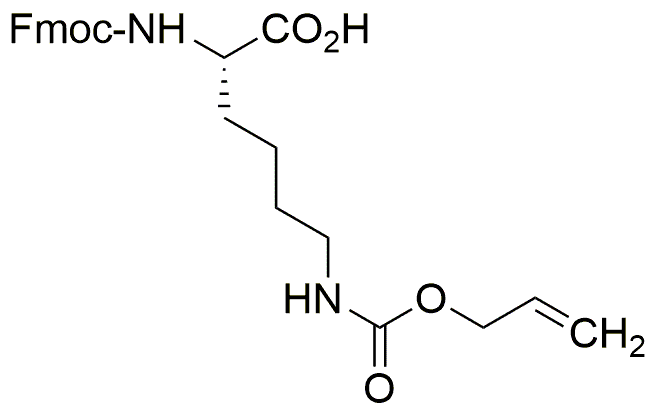Na-Fmoc-Ne-allyloxycarbonyl-L-lysine is widely utilized in research focused on:
- Peptide Synthesis: This compound serves as a protective group in the synthesis of peptides, allowing for selective reactions without interfering with other functional groups. Its stability under various conditions makes it a preferred choice for researchers in biochemistry.
- Drug Development: In pharmaceutical research, it is used to create modified peptides that can enhance drug efficacy. By modifying lysine residues, scientists can improve the pharmacokinetics and bioavailability of therapeutic peptides.
- Bioconjugation: The compound is valuable in bioconjugation techniques, where it facilitates the attachment of peptides to proteins or other biomolecules. This is crucial in developing targeted drug delivery systems and diagnostic tools.
- Protein Engineering: Researchers utilize it in protein engineering to introduce specific modifications to lysine residues, thereby altering protein function or stability. This application is particularly relevant in the fields of synthetic biology and enzyme design.
- Research on Post-Translational Modifications: It aids in studying post-translational modifications of proteins, which are essential for understanding cellular processes and disease mechanisms. By using this compound, researchers can mimic natural modifications and investigate their effects.
General Information
Properties
Safety and Regulations
Applications
Na-Fmoc-Ne-allyloxycarbonyl-L-lysine is widely utilized in research focused on:
- Peptide Synthesis: This compound serves as a protective group in the synthesis of peptides, allowing for selective reactions without interfering with other functional groups. Its stability under various conditions makes it a preferred choice for researchers in biochemistry.
- Drug Development: In pharmaceutical research, it is used to create modified peptides that can enhance drug efficacy. By modifying lysine residues, scientists can improve the pharmacokinetics and bioavailability of therapeutic peptides.
- Bioconjugation: The compound is valuable in bioconjugation techniques, where it facilitates the attachment of peptides to proteins or other biomolecules. This is crucial in developing targeted drug delivery systems and diagnostic tools.
- Protein Engineering: Researchers utilize it in protein engineering to introduce specific modifications to lysine residues, thereby altering protein function or stability. This application is particularly relevant in the fields of synthetic biology and enzyme design.
- Research on Post-Translational Modifications: It aids in studying post-translational modifications of proteins, which are essential for understanding cellular processes and disease mechanisms. By using this compound, researchers can mimic natural modifications and investigate their effects.
Documents
Safety Data Sheets (SDS)
The SDS provides comprehensive safety information on handling, storage, and disposal of the product.
Product Specification (PS)
The PS provides a comprehensive breakdown of the product’s properties, including chemical composition, physical state, purity, and storage requirements. It also details acceptable quality ranges and the product's intended applications.
Certificates of Analysis (COA)
Search for Certificates of Analysis (COA) by entering the products Lot Number. Lot and Batch Numbers can be found on a product’s label following the words ‘Lot’ or ‘Batch’.
Numéro de catalogue
Numéro de lot/série
Certificates Of Origin (COO)
This COO confirms the country where the product was manufactured, and also details the materials and components used in it and whether it is derived from natural, synthetic, or other specific sources. This certificate may be required for customs, trade, and regulatory compliance.
Numéro de catalogue
Numéro de lot/série
Safety Data Sheets (SDS)
The SDS provides comprehensive safety information on handling, storage, and disposal of the product.
DownloadProduct Specification (PS)
The PS provides a comprehensive breakdown of the product’s properties, including chemical composition, physical state, purity, and storage requirements. It also details acceptable quality ranges and the product's intended applications.
DownloadCertificates of Analysis (COA)
Search for Certificates of Analysis (COA) by entering the products Lot Number. Lot and Batch Numbers can be found on a product’s label following the words ‘Lot’ or ‘Batch’.
Numéro de catalogue
Numéro de lot/série
Certificates Of Origin (COO)
This COO confirms the country where the product was manufactured, and also details the materials and components used in it and whether it is derived from natural, synthetic, or other specific sources. This certificate may be required for customs, trade, and regulatory compliance.


